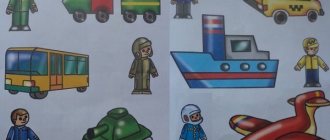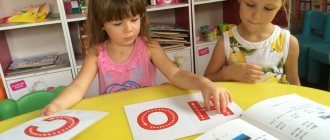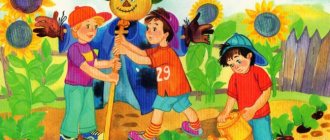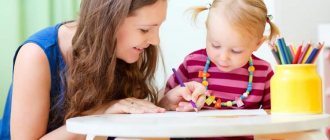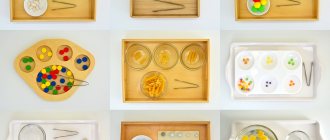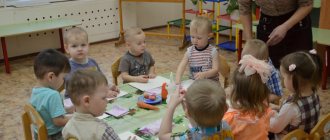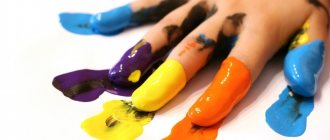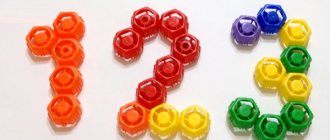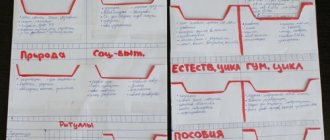By the age of three, every child should already have mastered the basic concepts that will help lay the basic foundation and develop intelligence. Many parents prefer to conduct classes at home, because children at 3 years old can be quite capricious. They do not yet know how to communicate with peers, are afraid to be in study groups and do not know how to maintain silence. Three-year-olds often look around and try to correct each other's answer, even if the answer was given correctly.
So, what activities should be done with three-year-olds?
First of all, math classes:
What should the baby learn?
- count to five;
- show your child simple geometric shapes: circle, square, triangle;
- teach your child to compare: more-less, better-worse;
- teach how to select pairs.
Please take into account that at three years old a child cannot concentrate on one subject for a long time. So during the day it is better to have 3-4 lessons of 15-20 minutes each than one hour-long lesson. Buy educational cards, counting sticks, puzzles and copybooks for educational activities.
Children at three years old can still put material in their mouth and chew paper, so it is better to laminate the cards. Otherwise, you will prepare a new set for each lesson.
Try to play educational games according to the following scenario:
- Show your child a card with a simple image.
- ask him to tell him what he saw in the picture, how many objects, what they are.
- If you have 1 more set of cards on hand, ask your child to find a pair in the second set.
Classes of this type can be carried out not only at home, but also on the street. In the summer, you can play the game “Pirate Treasures” with your son or daughter. Hand your child a map with a route, mark a couple of places with a cross and let your little one look for treasures. Motivate your child, tell him that he must solve this problem and help him if problems arise.
And if you have several children at home, then you can arrange a real competition between them. Children will have fun, explore the world and learn interesting things.
And if it's cool outside, play this game right at home. Just hide all fragile items.
Puzzles
Select puzzles for three-year-olds so that the picture is large and clear. And to start, take puzzles of 2-3-4 parts.
You can make an educational puzzle at home yourself. Take the picture and cut it into several squares. While the baby is putting together a puzzle, he will learn new words and numbers, develop attention and fine motor skills.
Copybooks
Copybooks are useful for kids, if only to develop their hands. Thanks to this material, kids learn to write letters and numbers correctly and draw neat lines. Again, you need to select such copybooks so that the images are large enough and the lines are clear.
Coloring pages
All kids love coloring books. Therefore, parents can and should use coloring books quite often. This material can be used at home, on the street, and at a party. For three-year-old children, it is best to buy coloring books that contain the image of the number itself and its name (this way the child will also practice reading).
Intellectual and creative development
At three years old, a child actively learns about surrounding objects and phenomena, explores his capabilities, and for this it is necessary to develop attention, logical thinking, memory, and imagination. What exercises will help?
- Search for the desired color by sample or name.
- Collecting nesting dolls, pyramids, molds of different sizes.
- Selection of volumetric and flat squares, circles, triangles and other geometric shapes.
- Games for the difference between the concepts of “small”, “large”, “medium”.
- Folding a picture-riddle: first from 2 two parts, then from 3-4 parts.
- Search for a whole picture by its piece.
- Generalization of objects according to the main characteristic: living-non-living, edible-inedible, etc.
- Game of mosaic, lotto, dominoes.
- Finding matches, for example, shadows and figures.
- Searching for an extra item in a group of other items.
- Adding missing details.
- Reading fairy tales together. If the child knows some letters, ask them to find them in the text.
Take every opportunity to teach your baby something new. For example, during a walk, tell him about trees, animals, phenomena, transport - in a word, about everything that you came across along the way.
The study of elementary mathematical concepts and numbers should take place in a playful way. Ensure that your child not only memorizes the names of numbers, but learns how to determine the number of objects.
To develop creative thinking, experts advise regularly performing the following exercises :
- playing with a construction set, cubes, creating structures based on a model;
- collecting simple puzzles;
- drawing and coloring with paints, pencils, felt-tip pens;
- drawing a variety of geometric shapes, you can use a stencil or pattern;
- modeling simple figures from plasticine, salt dough, clay;
- applications made from natural materials, colored paper and cardboard, magazine clippings;
- cutting along the contour with scissors, etc.
Children aged 3 enjoy playing story games, puppet theater, and participating in simple short dramatizations.
Logic classes:
What should a child of 3 years old be able to do?
- find and explain the error;
- see similarities and differences;
- remember pictures and words;
- concentrate attention.
Three-year-old children move a lot and cannot sit still for long. If they lack physical activity, the child begins to get irritated, cry and become hysterical. It is important for a parent to remember this when planning an activity with their baby. The maximum lesson time should be 20 minutes. Before classes, it is better to do a ten-minute physical warm-up.
After the lesson, praise your offspring. Tell him that he did well and that he deserves encouragement. As a reward, you can take your baby to the park or some playroom.
Try to interest your baby in playing associations and opposites. Such exercises are good for training reaction speed, speech skills, and logical thinking.
At this age, children perfectly understand and love fairy tales and different stories. Tell them more often and make some mistake on purpose, and let the baby find it. For example, you say that winter has come, and then in the middle of the fairy tale the heroes go to the forest to pick mushrooms and berries.
The following exercise perfectly develops the logic and imagination of children: you show the child several cards that are related in meaning. And then invite your child to add another card that would fit into the story. For example, you show cards of mom, dad and child, and your kid can add a cat or a dog or a beautiful house here. And let him try to explain why he added this card.
Developmental activities for children 3 - 4 years old “The world around us”
Author I. Bushmeleva. Artist N. Gubareva.
At the age of 3-4 years, a child should be able to determine the time of day without difficulty.
Task for a child : Look carefully at the picture and say what the artist mixed up, what he drew incorrectly, why?
A child aged 3-4 years usually already knows that different vehicles are driven by different people. Tell him the name of the professions “machinist”, “tanker”, so that these words will enrich your child’s vocabulary.
Task for the child: Pick a pair. What kind of transport does this or that driver drive?
The child must answer your questions. It is important to present everything in the form of a game.
Assignment (questions) for the child:
1. In the morning the sun rises, and in the evening... (sets)
2. It rained, and... (puddles) appeared on the asphalt
3. Birch has leaves, and pine has... (needles)
4. In winter it often snows white, fluffy... (snow)
5. Water flows from the tap. And when it freezes, it turns into... (ice)
6. Is the ice soft or hard? (solid). Can it flow like water? (No). Is it cold or warm? (cold). Is the water cold or warm? (can be cold and warm).
A 3.5-4 year old child must distinguish animals that can live in city apartments from animals living in the countryside.
Activity with a child: look carefully which of these animals live in the village.
We teach a child to recognize a tree by its leaves. We study the names of flowers.
Task for a child : look at the leaves, from which tree did they fall (birch, maple, willow)? What are these flowers called (chamomile, rose, tulip, cornflower)?
A child of 3-4 years old, of course, already knows wild animals (from fairy tales, pictures, poems). He must be able to describe the animal and tell some of its features.
Activity with a child : There are animals in the picture, name them. Which one of them lives, where does it live, what does it like to eat, what color is its skin, which one is bigger? What are the “legs” of a wolf (paws) called? What about the elephant's nose (trunk)? Which animal has the largest neck, ears, teeth?
A child of 3-4 years old should be able to separate vegetables from fruits and voice the fact that some fruits are vegetables (grow in the garden), and others are fruits (grow on trees).
Assignment for a child: Miraculously, the tree grew fruit. Name them. Look and tell me which fruits do not grow on trees. Where do they grow?
A child aged 3-4 years already knows that there are adults and children. But what are they called correctly?
Activity with a child : Please tell me who is drawn in this picture (animals, beasts)? Please note that these are parents and their children. Do you know what they are called? (elephant (elephant) - baby elephant, bear (shema bear) - bear cub, cat (cat) - kitten, tiger (tigress) - tiger cub).
A 3.5-4 year old child should already know polite words and be able to use them correctly.
Lesson with a child: question - answer. Ask your child to answer your questions.
- In the morning you woke up and went to brush your teeth, on the way you met your mother. What will you tell her? (Good morning).
- In kindergarten, the girl Tanya treated you to an apple, and you told her... (thank you).
- You have friends? What are their names? If your friend asks you to help him, what will you do? (I'll help).
- Do you go to kindergarten? What time of day do you come to kindergarten (in the morning), and when do your parents pick you up (in the evening).
- What do you say to your family when you go to bed (good night).
- You came to visit a friend, what will you say when you see him? (Hi Hello).
- Mom asked you to help her clean the room, what will you do? (I’ll help, collect toys, etc.).
- Grandma was knitting socks for you, and her ball of yarn fell, what will you do? (I'll pick it up).
Speech classes:
What should the baby learn?
- his sentences should consist of 5-6 words;
- he can say his first name, last name, and the names of his parents;
- knows how to distinguish objects by characteristics;
- understands the meaning of actions (walk, run, cry, search, play, etc.)
At home, you can invite your child to collect cubes or cards with letters so that he learns to collect words. In three-year-olds, the memory is not yet particularly developed, so give the tasks not difficult so that he can easily collect the hidden word.
Household activities:
What should the baby learn?
- must be able to dress and undress independently;
- cut out various pictures;
- color pictures;
- must understand the basic rules of accuracy.
Parents often hang posters and pictures around the house with hygiene rules. Every time a baby passes by, he remembers and remembers that he needs to wash his face and brush his teeth regularly.
Try to develop creative skills in your son or daughter. Once every 1-2 months, organize holidays or celebrations at home, for which you need to prepare costumes, decorations, etc. Involve your baby in the preparation. Let him help you.
If you don’t have enough time to organize holidays, make crafts together from different materials. Remember to use pine cones, leaves, acorns and other natural materials.
Cognitive activities:
What should the baby learn?
- know some animals;
- know some plants;
- distinguish a vegetable from a fruit, a berry from a mushroom;
- know and understand natural phenomena (rain, snow, sun);
- distinguish the time of year and day.
Prepare images of various animals, birds and plants. Try to choose images of those plants and animals that you can find in your area. Then during your next walk you can show them to your baby and tell them some interesting facts and stories about them.
Sports activities:
Physical exercise is just as important for three-year-olds as intellectual exercise. When the child goes to school, he will be able to do all the exercises in physical education lessons. He will also be able to play outdoor games with classmates without any problems and will be able to show his endurance and dexterity. At this age, children strive to spend time with those with whom they find it interesting and fun. If your child is sedentary and inactive, the number of his friends may decrease sharply.
Start your morning with a simple invigorating exercise. Do some exercises to warm up your muscles and stretch. If you wish, you can start your morning with a run.
Girls love different dances, the main thing is that cheerful music is playing at this moment. Boys prefer playing with a ball. You can include all this in your daily routine and have fun together.
In any case, you will need all kinds of equipment to perform the exercises: small dumbbells, balls, a jump rope, hoops, and so on.
Three-year-old children are very inquisitive and smart. At this age, children develop their first habits. If you are able to correctly create a daily routine for your child and keep him busy with useful and educational exercises, your work will definitely be rewarded.
Physical development of the child
The main goal is to make the child stronger, more resilient, dexterous, and teach him to coordinate his movements well. Experts recommend doing the following exercises daily:
- stepping over small obstacles;
- walking on an inclined plane;
- jumping over a drawn line (like playing hopscotch);
- walking on a string placed on the floor;
- jumping forward on both legs;
- jumping from low heights.
It is very useful for three-year-old children to swim, dance, play various ball games, ride a bicycle, and perform various exercises on the children's sports wall. Be sure to teach your child to do morning exercises or do fitness with him.
